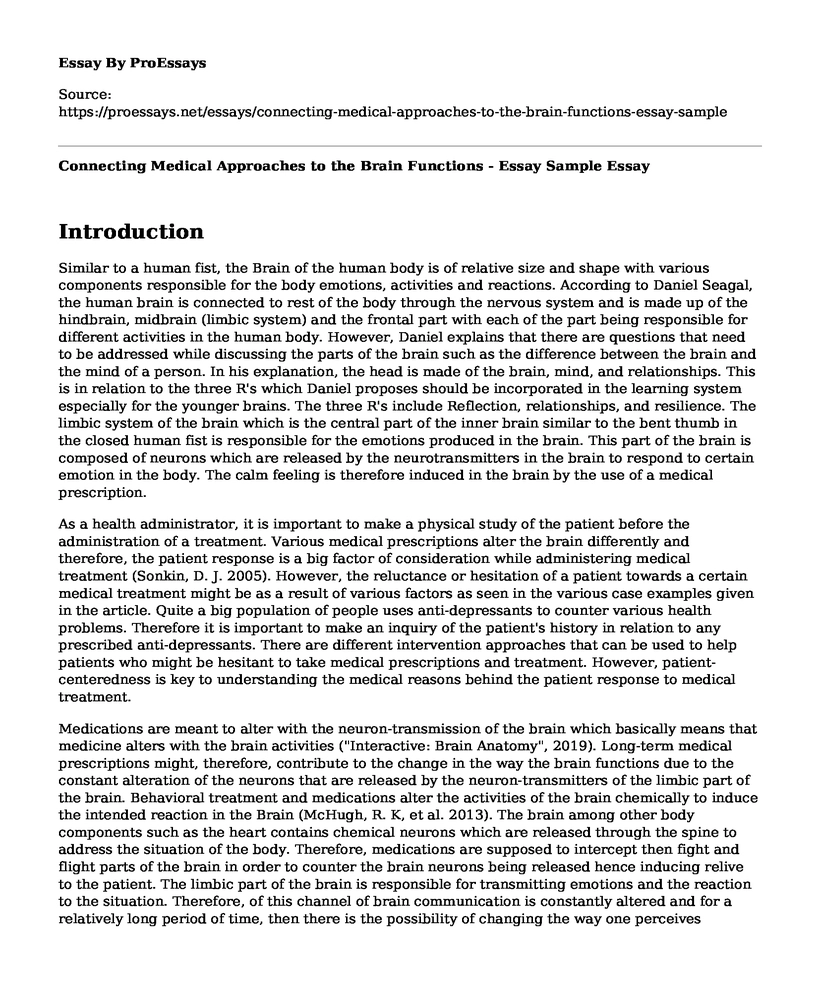Introduction
Similar to a human fist, the Brain of the human body is of relative size and shape with various components responsible for the body emotions, activities and reactions. According to Daniel Seagal, the human brain is connected to rest of the body through the nervous system and is made up of the hindbrain, midbrain (limbic system) and the frontal part with each of the part being responsible for different activities in the human body. However, Daniel explains that there are questions that need to be addressed while discussing the parts of the brain such as the difference between the brain and the mind of a person. In his explanation, the head is made of the brain, mind, and relationships. This is in relation to the three R's which Daniel proposes should be incorporated in the learning system especially for the younger brains. The three R's include Reflection, relationships, and resilience. The limbic system of the brain which is the central part of the inner brain similar to the bent thumb in the closed human fist is responsible for the emotions produced in the brain. This part of the brain is composed of neurons which are released by the neurotransmitters in the brain to respond to certain emotion in the body. The calm feeling is therefore induced in the brain by the use of a medical prescription.
As a health administrator, it is important to make a physical study of the patient before the administration of a treatment. Various medical prescriptions alter the brain differently and therefore, the patient response is a big factor of consideration while administering medical treatment (Sonkin, D. J. 2005). However, the reluctance or hesitation of a patient towards a certain medical treatment might be as a result of various factors as seen in the various case examples given in the article. Quite a big population of people uses anti-depressants to counter various health problems. Therefore it is important to make an inquiry of the patient's history in relation to any prescribed anti-depressants. There are different intervention approaches that can be used to help patients who might be hesitant to take medical prescriptions and treatment. However, patient-centeredness is key to understanding the medical reasons behind the patient response to medical treatment.
Medications are meant to alter with the neuron-transmission of the brain which basically means that medicine alters with the brain activities ("Interactive: Brain Anatomy", 2019). Long-term medical prescriptions might, therefore, contribute to the change in the way the brain functions due to the constant alteration of the neurons that are released by the neuron-transmitters of the limbic part of the brain. Behavioral treatment and medications alter the activities of the brain chemically to induce the intended reaction in the Brain (McHugh, R. K, et al. 2013). The brain among other body components such as the heart contains chemical neurons which are released through the spine to address the situation of the body. Therefore, medications are supposed to intercept then fight and flight parts of the brain in order to counter the brain neurons being released hence inducing relive to the patient. The limbic part of the brain is responsible for transmitting emotions and the reaction to the situation. Therefore, of this channel of brain communication is constantly altered and for a relatively long period of time, then there is the possibility of changing the way one perceives situation and emotions as well as the relative reactions.
References
Interactive: Brain Anatomy. (2019). Retrieved from https://www.koshland-science-museum.org/explore-the-science/interactives/brain-anatomy
McHugh, R. K., Whitton, S. W., Peckham, A. D., Welge, J. A., & Otto, M. W. (2013). Patient preference for psychological vs. pharmacologic treatment of psychiatric disorders: a meta-analytic review. The Journal of Clinical Psychiatry, 74(6), 595-602.
Sonkin, D. J. (2005). Attachment theory and psychotherapy. The California Therapist, 17(1), 68-77.
Cite this page
Connecting Medical Approaches to the Brain Functions - Essay Sample. (2022, Nov 30). Retrieved from https://proessays.net/essays/connecting-medical-approaches-to-the-brain-functions-essay-sample
If you are the original author of this essay and no longer wish to have it published on the ProEssays website, please click below to request its removal:
- Organic Food vs. Genetically Modified Food
- Essay Example on Superior & Inferior Muscles of the Eye: Function & Movement
- Research Paper on Uniting to Thwart the Worldwide Extinction Crisis
- Saving the Bees: The Need for Animal Protection and Preservation - Research Paper
- Essay on Prevent Zebra Mussel Infestation: Best Option for Water Bodies
- Gene Patents: Unlawful & Unjust? - Essay Sample
- Genes Affect Cognitive Processes - Essay Example







